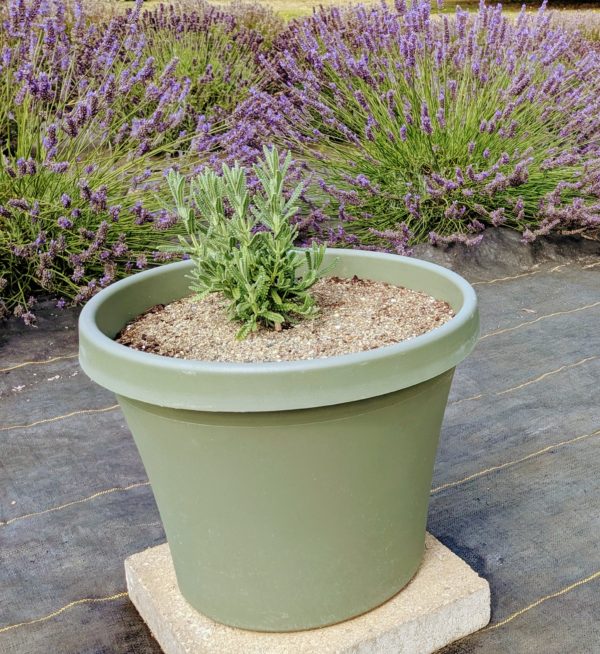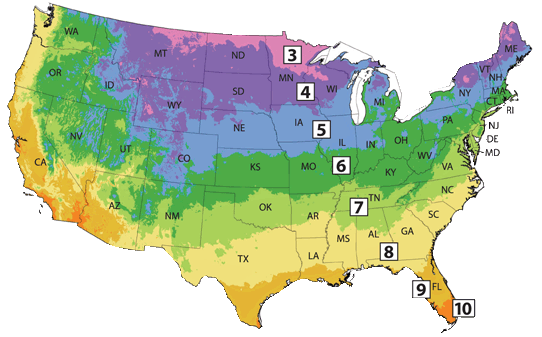Tips for planting lavender
- New plants need time to establish before scorching heat or hard freezes
- Make sure the location gets plenty of sunshine
- If your soil is not well drained, you will need to amend it.
- Make sure your plants have plenty of air circulation.
- If you must plant in a container, choose an angustifolia (“English”) or stoechas (“Spanish”) variety
Whether you just bought some starts from your local nursery, or you tried your hand at propagating (read: parts one, two, and three of our Lavender Propagation blog series) you have new lavender starts that you’re ready to plant! Before you dig your first hole, read on for some tips and considerations to ensure your lavender survives and thrives in it’s forever home.
Lavender is a hardy plant, but young lavender still needs care and consideration in order to set it up for success.
When to plant out?
Your best first step for planting anything is to first determine your USDA hardiness zone, and then research (aka “ask google”) what the recommended times are for planting a particular plant in that zone. Key factors to consider:
- Plant after spring’s last freeze date and at least 12 weeks before winter’s first freeze, so young roots aren’t damaged.
- If you live in a dry/arid climate, plant in the rainy season or have a plan for regular watering (irrigation or hand watering).
Since our summers are typically dry, we either plant in early May, or early September. The new plants still need to be watered, but planting in early spring gives them 4-8 weeks of fairly regular rain to keep them happy before hot weather hits in mid-July; planting in early September gives them time to establish as rain becomes more frequent, before the first freeze of winter.
Where to plant?
Sunlight
Most everyone knows that lavender is a sun-loving plant. Be sure you select a spot that gets a minimum of 6 hours of direct, unfiltered sunlight a day (more is fine). The light can be broken up, (eg. 3 hours in the morning, 3 hours in the late afternoon) if your perfect spot has a large tree blocking the sun, for example.
Distance
In addition to needing lots of sunlight, lavender also needs good air circulation. Humidity can be as much of a problem as waterlogged soil, so ensure that your plants aren’t too close to each other or to other structures/plants. Keep in mind that lavender species grow to different sizes: angustifolia and stoechas varieties typically stay smaller (12”-24”), while intermedia can grow to a diameter of 36” or more; your best bet is to research the variety before you place it. The tips of the plant can be touching – just don’t cram them in right next to each other. Ensure that your plant has space to grow and breath!
What kind of soil?
The second, just as important consideration for where to plant lavender (that is often missed) is soil quality.
Drainage
Lavender prefers very well drained (rocky or sandy) soil that is not rich in organic matter. Lavender roots will rot if they sit in water. So, what to do if your perfect spot has imperfect soil?
- If you have compacted/clay soil, mix in 50% gravel or sand before you plant.
- If your water table is high, create a 12-24” mound/berm for the lavender. Lavender roots are shallow, so this should easily keep the roots above the water table.
pH level
Lavender also prefers alkaline soil (pH 6.5+). It’s not as critical as drainage, but if you’ve had issues with lavender in the past, test your soil and, if necessary, be prepared to amend it when you plant.
Container Planting
If it is too difficult for you to find a sunny spot with well drained soil, keep in mind that you can plant lavender in pots. There are many varieties bred specially to stay small (eg. “Thumbelina”), but in general, angustifolia or stoechas varieties should be fine in a pot – intermedia varieties are too large for containers. If you plant in a container, you still need to treat it as an outdoor plant (lavender does not survive as a houseplant.) Keep in mind that you’ll need to take care to protect the plant roots in the winter. Since the roots in an above ground container will be approximately 15 degrees colder than roots in soil, you’ll need to protect the plant in the winter by either a) moving it inside a greenhouse or b) moving it against a sunny wall protected from the wind, and wrapping or covering the pot.

“For lavender container planting, the pot should be as big as the plant foliage (not including stems). I suggest a 12” pot for first year lavender starts, moving to a 24” pot the next year when the plant is more mature."
—Farmer Rick
Summary
Key tips to remember before planting out your lavender:
- New plants need time to establish before scorching heat or hard freezes
- Make sure the location gets plenty of sunshine
- If your soil is not well drained, you will need to amend it.
- Make sure your plants have plenty of air circulation.
Once you’ve chosen your location you’re ready to plant! Next up: check out our blog post on how and why you should prune young lavender plants.
pssssst – Thanks for reading our blog! Curious about our natural lavender bath & body products? Enter code ehma3jd6 at checkout for 5% off your next bath & body order at our online store!

7 Replies to “Lavender Care: When and where to plant?”
Franklin
The climatic condition need to grow lavender tree and how to distle oil from lavender plant.
Rebecca Olson[ Post Author ]
The best climate for lavender is Mediterranean (mild, warm, and sunny) with sandy, well drained soil. To learn about essential oil extraction, check out my blog about that!
Did my lavender plant survive? - Lavender Connection
[…] this is a good time to try and determine the cause of the plant’s demise (see our blog about how to pick a good spot for lavender), so you can make adjustments and be more successful with your next […]
Lavender Care: Should I prune young lavender plants? - Lavender Connection
[…] and purchased an adorable new lavender plant at your local nursery. You read (and followed) our tips for where and when to plant. Your little lavender buddy is now thriving after a warm summer with plenty of sunshine and well […]
The Best Way To Care For Your Lavender Plants
[…] Lavender plants are drought tolerant and can tolerate a wide range of soil types, and they can be planted in the ground or in containers. […]
Shirley
This will be my first year of planting Lavender. The planter container is 22” across and 13 1/2” deep. How many drain holes should I drill in the bottom? I was going to put 1 plant in each of those planters? They will get plenty of sunlight I am in zone 7. Any help would be appreciated. Thank you.
Rebecca Olson[ Post Author ]
I would put as many holes in the bottom as you can while still keeping the container structurally sound. With only 13.5″ depth, the roots are going to eventually get to the bottom of the container – and you definitely don’t want them sitting in water. You’ll need to do some extra watering in the dry summer months but good drainage will ensure the plants don’t dry in the rainy/snowy season because the roots are waterlogged. Be sure you buy lavender varieties that are meant to grow in containers: only lavandula angustifolia, and if possible, find varieties that are cultivated for containers, eg. Thumbelina or Lavanite Petite. If you can’t find those, try to find Hidcote (which is smaller). Good luck!